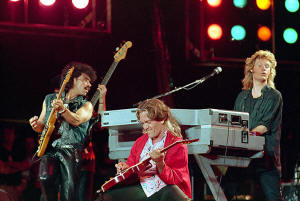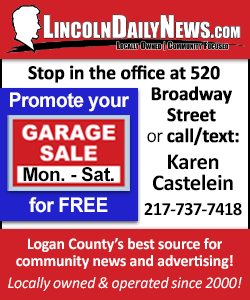Judas Priest, Rick Springfield, John Oates and Bob Geldof reflect on 40
years of Live Aid
[July 10, 2025]
By MARIA SHERMAN
NEW YORK (AP) — Forty years ago, the legendary Live Aid concerts aimed
to do a lot of good — helping to raise over $100 million for famine
relief in Ethiopia and inspiring worldwide awareness for a cause it
might otherwise have ignored.
Simulcast from Philadelphia and London on July 13, 1985, Live Aid was
the most ambitious global television event of its time: 16 hours of live
music in two different continents featuring Queen, The Who, a Led
Zeppelin reunion and more.
A lot has changed in the years since. “Live Aid, '85 to now, is the same
distance as the Second World War from Live Aid,” notes Rick Springfield,
laughingly. “That’s how long ago it was.”
Artists who performed at Live Aid — Springfield, organizer Bob Geldof,
Hall and Oates' John Oates and Judas Priest's Rob Halford — reflected on
the event and its impact in interviews with The Associated Press ahead
of the 40th anniversary on Sunday.
Here's what they had to say:
Reflections on an unprecedented event
At John F. Kennedy Stadium in Philadelphia, Springfield performed
between Run-DMC and REO Speedwagon — just a taste of the diversity of
performers featured on the transnational lineup. “Run-DMC, I remember
thinking, ‘What is this? Three guys talking over a record player. What
is that? Little did I know that it was about to change the whole game,”
he says, laughing. He remembers playing an electric set — no “Jessie’s
Girl,” because “back then, it was just my first hit. ... It hadn't gone
on to become this cultural thing."

Hall and Oates' John Oates had a different experience. His band also
played in Philly — their hometown — and in 1985, his band was one of the
biggest on the planet. They played near the end of the night, joined by
the Temptations' Eddie Kendricks and David Ruffin and remained on stage
to back the Rolling Stones' dynamic frontman Mick Jagger. The British
rockstar had a trick up his sleeve.
“He didn't tell us that he was bringing Tina Turner out,” Oates says.
“We had rehearsed a certain amount of songs with him. But then when he
brought her out, it just jacked up the level of energy like you can’t
believe.”
Judas Priest singer Rob Halford counts “Mike and Tina, of course,” as
one of his Philly Live Aid highlights. “Led Zeppelin, too.”
But most exciting of all for the heavy metal frontman? Meeting folk hero
Joan Baez. The band had previously covered her classic “Diamonds and
Rust."
“I thought, ‘Oh my God, she’s gonna come and kick me in the ass for
wrecking her beautiful song,’” he recalls. “She gives me a quick hug and
goes, ‘The reason I’m here is because my son said to me, if you see Rob
Halford from Judas Priest at the Live Aid Show in Philadelphia, will you
tell him from me that I prefer Judas Priest’s version to my mom’s
version?' ... It was a display of such kindness."
[to top of second column]
|

John Oates, from left, G.E.Smith and Daryl Hall perform at JFK
Stadium in Philadelphia for the Live Aid famine relief concert on
July 13, 1985. (AP Photo/Amy Sancetta, File)
 From Live Aid to Live 8 and
beyond
Twenty years after Live Aid, Geldof organized Live 8 — an even
larger undertaking in the new internet era, with 10 concerts
happening simultaneously and across the globe.
If the trend were to continue, there should be another event taking
place this year. Notably, there isn't.
Geldof says that's because there couldn't be a Live Aid-type event
in 2025. He cites social media as a cause. In his view, algorithmic
fracturing has made it impossible to create monolithic musical and
activistic moments. Instead, he views the current media landscape as
bolstering "an echo chamber of your own prejudices.”
For something like Live Aid to work, “You need rock ‘n’ roll as a
creature of a social, economic and technological movement," he says.
“And I think the rock ‘n’ roll age is over. ... It did determine how
young people articulated change and the desire for it. ... That
isn't the case anymore.”
Springfield agrees. “I think we are too divided,” he says. He
believes the world wouldn't be able to agree on a single cause to
support, or even which musicians to back. “You could never do a
thing with the size of Live Aid unless it was some kind of universal
thing of, ‘Let’s bring everybody together.’”
“Never say never, but I highly doubt it,” says Oates. “The landscape
of music and entertainment in general has changed so drastically."
He points to “We Are The World,” the 1985 charity single for African
famine relief that included the voices of Michael Jackson, Willie
Nelson, Bob Dylan, Ray Charles, Diana Ross, Stevie Wonder, Smokey
Robinson, Paul Simon and many more, as an example. “The idea of that
happening with the stars of today all in one place, I can’t even
imagine that. And plus, who would they be? ... How many songs are
released every day?”
Hope for he Live Aid's legacy to continue
Halford echoes the other's sentiments. There's an undeniable
“extremism in the world right now,” he says, that would make a Live
Aid event challenging to pull off in 2025. But he doesn't think it's
impossible. He uses January's Fire Aid — the LA wildfire benefit
concert featuring Billie Eilish, Stevie Wonder and a Nirvana reunion
— as a recent example.
“There will always be empathy from people,” and in the right hands,
maybe another event like Live Aid could take place. “It was a
tremendously beautiful, humanitarian example ... that provided us
opportunity to do something ourselves to help.”
All contents © copyright 2025 Associated Press. All rights reserved
 |